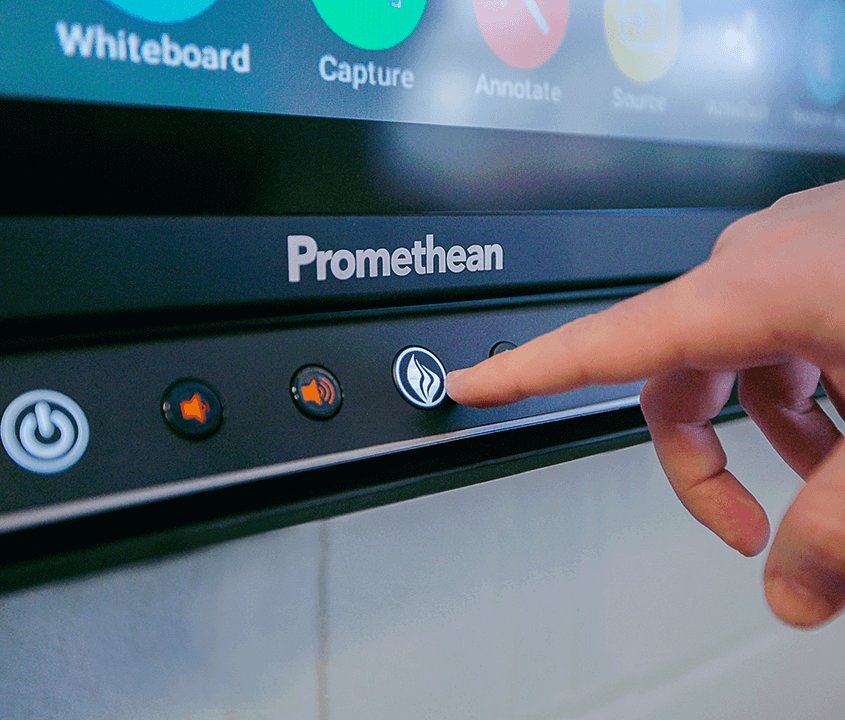By Ryan Thornton, Promethean Education Consultant.
First off, we’d like to take a second to give MAJOR props to the teachers that taught on these bad boys. We appreciate all of the hard work and effort you had to put in, and all of the smells and sounds and sneezes you had to put up with. Of course, we all know that a lot has changed since the days of blackboards and chalk. They have been replaced with interactive whiteboards, and lucky for you, we are in the middle of an interactive whiteboard renaissance. Let us explain.
What is an interactive whiteboard?
In its simplest form, an interactive whiteboard is your new blackboard, your new dry-erase board, it is where you prepare your guiding questions, create your equations, and take your notes. It is also where you have students write their answers, show their work, share their thoughts. It can be at the center of the room and the focal point or can be moved and used as a supplement, or in small group work. These basic needs of an educator are not going anywhere, it’s just that with an interactive whiteboard you can do all those basics with greater ease and flow, plus you have hundreds of features at your fingertips that will make your lessons more engaging. With an interactive whiteboard, the teacher can spend more time teaching and less time preparing and erasing (sneezing) which is a win-win.
Let’s get specific, what does it do? Specifically.
Let’s. But first, to make sure we are on the same page, we are not discussing every feature of a Promethean Panel today, we are focusing on the whiteboard app. Good? Good.
With a Promethean-designed pen, or any stylus on the market, or one’s finger, teachers and students can immediately start creating and interacting on our whiteboard.
- Your most commonly used types of paper and backgrounds are ready to go (e.g. graph paper, music notation paper).
- Your favorite charts and templates are a click away (e.g. Venn Diagram, Periodic Table).
- Do your students want to take a deeper dive than you were planning on … the habitat of a honey badger? The entire internet can be quickly accessed, allowing photos, diagrams and more, to be brought into the whiteboard space. They can then be manipulated, labeled, saved, sent out to the cloud, and accessed from anywhere with an internet connection.
- Teachers and students can collaborate with up to 20 simultaneous touch points and simultaneous pen, touch, and palm erase. Resize, drag, and move multiple windows to multitask and teach from several content types or apps at once.
Pros and Cons of Interactive Whiteboards
| PROS | CONS |
| Improves student-teacher collaboration and interaction. | Expensive |
| Encourages teachers to teach in real-time with audios and video lessons, visual multimedia & PPT presentations, 2D & 3D virtual space, etc. | Not simple for every staff member to handle (this is why robust and hands-on training is necessary). |
| Seamlessly integrates with other technology-enhanced learning (TEL) applications such as LMS to share study materials, course curriculum, assignments, reading resources, and many more. | If a teacher uses it for “substitution” while teaching with the same old approaches. For example, “Now we will watch a movie children, and it’s going to look and sound better than before we got the panel.” And then the teacher proceeds to check-out. |
| Creates web and internet-based teaching and learning platforms for teachers and students respectively. |
Source: Exerted from Edusys.com (2020)
How can I get the most out of my Interactive Whiteboard?
The whiteboard will seamlessly “talk to” (and play nice) with all of the teacher’s current favorite programs. In the morning, the teacher can bring in that PowerPoint that he/she loves, and at the end of the day share it out to student devices through Google Classroom so the learning continues once they have left the classroom. The interactive whiteboard can do anything a computer, tablet, or smartphone can do. You will no longer need to connect an external device. I know, it’s exciting. No more fussy cord connections or lost dongles. BUT! You CAN connect any external device wirelessly, with an HDMI cord, with a USB cord, or with a VGA cord. This is comforting to many teachers who don’t want to take the big jump right off the bat, but with proper training and support, they will get there. The learning continues, but it’s become a lot more colorful these days.

